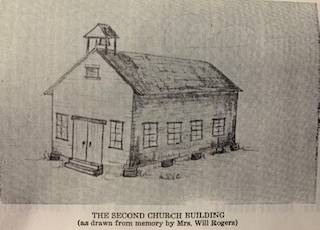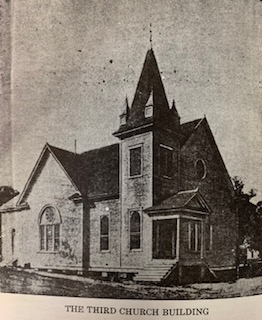History of the Church Congregation of Center
As early as 1856 groups of Christians became associate into congregations usually without buildings or formal organizations in the following communities: Antioch, Willow Grove, Buena Vista, Oak Grove, Logansport, Myrtle Springs, Eagle Hill, New Prospect, Shelbyville, Weaver Community, Center, Pleasant Grove, Timpson, and in other points over Shelby County. These little bands of disciples met for Bible study, prayer meetings and revivals in their homes, in schoolhouses, and under brush arbors. Of these communities the Antioch church seemingly is the oldest, then the Willow Grove church under the leadership of Mr. and Mrs. T.H. Day, Mr. and Mrs. George King, Major and Mrs. Alfred Truitt and Mr. and Mrs. Leggett.
The early evangelistic efforts from 1856 to 1872 in the various communities of Shelby County were sustained by Brother P.F. Southern with the help of Council Billingsley, John R. Tyre, and George N. Weaver, Alfred Padon, John F. Brill, D.A. Leak, and R.H. Bonham. Many of the communities were instructed and preaching services held by the Elders i.e., Elder Edward Marshall Hughes in the Oak Grove Church (he was the first elder in Shelby County.)
Appearing in the “Millenial Harbinger New from the Churches” of January 1857 is the following report:
Texas – “Brother P.F. Southern reports some 25 additions in Shelby County who have united themselves on the Bible alone as their faith and discipline.”
Brother Southern was a typical pioneer preacher who moved into our county about 1856 and purchased a farm in the Pleasant Grove Community and there built the first white house in this section of county. It was he who revived the work begun in 1847 by Dr. William Defee at Shelbyville.
The second property in the way of a building for the congregation in Center was a small wooden structure on the west side of the town, west of the present grammar school secured by 1886. The members living in Center or near were Eli Weaver Ben Downer, Jim Stevenson, Tom Jones, Jesse Padon, the Liems, the Fussells, the Mounds, Dr. Larkin, Price Daugherty, the McLamores, the Cartwright, Mrs. J.S. Gholston, Mrs. Ed Sanders, the Pleas Jonesfamily,y and a few others.
The most ambitious venture, undertaken in Shelby Count during the nineties, was the founding of a school by D.A. Leak and R.H. Bohnam at Patroon, Texas in 1893. The school group grew to as many as 300 pupils at one time. Some graduates and pupils of this school that we know today are: Mrs. P.L. Sanders, Mrs. F.L. Runnels, Mr. B.M. Alford Mrs. W.G. Hartt of Marshall (sister of Judge W.C. Hurst), and Rev. Tolbert Weaver of Houston.
Brother George Weaver, still at this time 1890, active preacher, with his sons Elbert, Herman, Raymond, and Willie, contributed much to the church services wherever they would hold services.
On January 11, 1905, for the consideration of $250 cash, the southeast corner of Lot 1, Block 37 (now occupied by Southwestern Bell Telephone Company) was purchased from E.A. Blount of Nacogdoches. The names of the trustees for the Christian Church of Center were G.P. Daugherty, W.B. Downer, and W.L. Morrow, appear on the general warranty deed. The deed of trust as authorized by the congregational vote, the signatures of these trustees “acknowledged us held and firmly bound unto the Board of Church Extension of the American Missionary Society to the sum of $800. This loan was for the purpose of completing a church building on the recently acquired property dated February 1, 1905. (Note: this was when First Christian parted with Center Baptist Church.)
On March 15, 1920, the remainder of the property (on which the present church and parsonage are now located) known as the Blount addition was purchased for the sum of $2000. With Elders C.R. Fussell, J.L. King, Jesse Padon, A.C. Smith, and Noble Weaver as purchasers.
Believing it to be of great advantage to the church, the organization voted July 6, 1930, to ratify a sale contract between Noble Weaver, Roy Payne, and C.A. Smith for the church and the Southwestern Bell Telephone Company to see part of the lot on which the church house and Sunday School rooms to be built, was their vision. Accordingly, $5000 was paid to the church for this piece of property. Brick veneer was placed on the wooden church when moved to the present location and a two-story Sunday School room space was added on the west side.
Interesting Facts -- With the moving and remodeling of the church in 1930, the church began to grow steadily; this was accomplished largely through the splendid efforts of pastor, Dr. Chasteen, who had an excellent business ability. The first piano owned by the church was purchased in 1906, this was replaced with an electric reed organ in 1932. Then in 1946 a Hammond electric organ and chimes were purchased. 1949 a new piano was purchased largely by the Women’s Council. 1947 saw the creation of a tastefully decorated parlor and nursery. The memorial windows were gifts of various families given in memory of loved ones, added in 1945.
The Following Years 1949-1981
A time of slow but steady progress seems to have set in during Dr. Griffiths ministry. A number of new ideas had taken hold at that time and over the nation there was a general concern with religion following the end of World War II. Two or three important changes took place here as a result.
In 1949 the Board voted to participate in a regular radio program which has continued, with two or three discontinuations, since that time. Originally the program was paid for by concerned individuals. Now, however, it is a regularly budgeted item.
As the church continued to grow, it became evident that more space was need for the educational program. So, in November of 1950 it was decided to purchase the Mary Jones home at 312 Shelbyville Street for a parsonage and convert the old parsonage, located at the rear of the sanctuary, into a Sunday School and Youth building. This building was called the Youth Center. A vital youth program was soon developed under the leadership of the A.H. Hookers. Soon after Ronald Scriven arrived for his first stint as minister, the question arose at the Board Meeting as to “what the children should be allowed to do at the Youth Center?”. The decision was: “To allow them to do what they wanted to as long as they did not carry it off!” Obviously, the leadership was satisfied with the Youth Program, the only one in town at that time.
Bill Griffiths resigned in August 1951 and was succeeded by Bob Matheny that following September. Mr. Matheny left in November 1953 and was followed by Ronald Scriven in December. His ministry was very successful, resulting in more necessary changes.
As the church grew, so did the Telephone Company. In 1954, the Southwestern Bell Telephone Company bought a 50 foot by 50-foot plot of the southwest corner of the church property. This purchase made the Telephone Company own the whole south side of the original church plot.
Trouble had developed with the organ and had continued for some time. In July of 1955, the Christian Women’s Fellowship came to the rescue and had the organ reconditioned.
It soon became obvious to the Scrivens that a kindergarten was needed in the community. Such a school was started in our church building with Mrs. Audra Scriven, a certified teacher, as its director. When the Scrivens resigned in 1956, this school was continued by Mrs. Jack Bell. It was so successful that it overgrew our church facility and had to be moved to a special building at the Bell home.
Change continued. It soon became necessary to make the church building more comfortable and appealing. So, in May 1956 the building was air conditioned. In May 1957 the parsonage at 312 Shelbyville Street was sold and a new house was leased at 515 Shelbyville.
The later years for the church were years of trouble and strife at First Christian. Where growth had been the hallmark of the ‘50s for the general church, and for Center in particular, the early ‘60s were identified with disruption, strife, and confusion. It is sad when such happens and especially when it strikes a small church. Many pastors were to come and go as well as members of the church.
A new Hammond organ was purchased in November of 1976. Mrs. Bertha Hooker built and furnished a Prayer Room in memory of Mr. A.H. Hooker. This room is located in the bell tower corner of the sanctuary.
A Mr. Mills remodeled a number of rooms. These included the minister’s study, a restroom and chancel area of the sanctuary. The top room of the church building was remodeled and furnished for special youth activities. In May of 1978 the church year was changed from July 1 to January 1 in keeping with the recommendations of the General Assembly. The Youth Choir was re-established at this time.
As vandalism was increasing everywhere it became necessary to try to protect the stained windows in the sanctuary. A decision was made to cover them with a special plastic covering. The families of those named in the Memorial Windows were asked to help provide the coverings. New hymnals were also needed. So, as Memorial Funds were available, the order for these hymnals was approved in July 1980.
Most of the names that have been mentioned in the history of these latter years have been those of ministers. But regardless of the minister’s capabilities, nothing took place during his ministry would have been accomplished without the concern and dedication of various members who, in some instances, promoted and carried on projects by themselves.
Note: The exhibit of quilts will only run until the end of May so if you haven’t seen the quilts, please make plans to do so soon. Also please consider being a member of the Shelby County Historical Society as this is our main source of income. It is only $25 per year for a family. We need your support!!!

